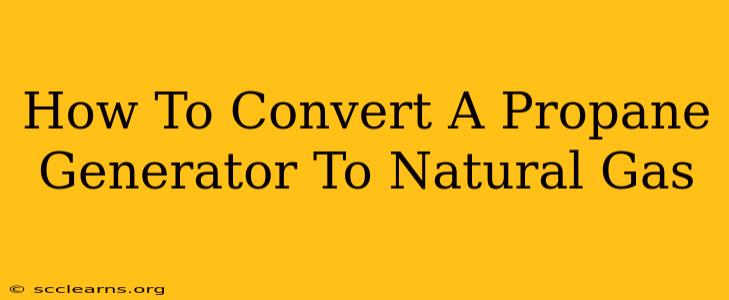Converting your propane generator to natural gas can be a rewarding DIY project, offering cost savings and potentially increased efficiency. However, it's crucial to proceed with caution and precision, as improper conversion can lead to dangerous consequences. This guide provides a step-by-step approach, emphasizing safety and compliance.
Understanding the Conversion Process
Before you begin, it's essential to understand the core differences between propane and natural gas. Natural gas has a lower pressure than propane, requiring a regulator change and potentially additional adjustments to your generator's fuel system. Safety is paramount, so always consult your generator's manual and adhere to all local regulations.
Key Differences & Considerations
- Pressure: Natural gas operates at significantly lower pressure than propane.
- BTU Content: Natural gas has a lower BTU content per cubic foot compared to propane. Your generator's performance might be slightly affected.
- Safety Precautions: Natural gas is lighter than air and can escape unnoticed, leading to potential explosions. Always follow proper safety procedures.
- Professional Help: If you are uncomfortable with any part of this process, seek help from a qualified technician.
Necessary Tools and Materials
Before starting the conversion, gather all the necessary tools and materials. Having everything prepared beforehand ensures a smooth and efficient process.
Essential Tools:
- Appropriate Conversion Kit: This is specific to your generator model and is crucial for a safe and effective conversion. These kits usually contain a new regulator and potentially other necessary parts.
- Wrench Set: To remove and install the old and new regulator.
- Screwdrivers: Phillips and flathead, for accessing various generator components.
- Gas Line Wrench: For working with the natural gas connection.
- Soap and Water Solution: To detect gas leaks.
- Safety Glasses and Gloves: Essential safety equipment.
Additional Materials (Potentially Needed):
- Gas Line: Depending on your setup, you may need additional gas line to connect to your natural gas supply.
- Gas Line Connectors: Ensure compatibility with your existing gas line and the generator's connection point.
Step-by-Step Conversion Process
This is a general guideline, and the specific steps may vary depending on your generator's model. Always refer to your generator's manual and the instructions provided with your conversion kit.
Step 1: Safety First!
- Turn off the generator: Ensure the generator is completely off and disconnected from any power source.
- Disconnect the Propane Tank: Safely disconnect the propane tank from the generator.
- Ventilate the Area: Ensure adequate ventilation to prevent gas buildup.
Step 2: Remove the Old Regulator
- Locate the Regulator: Identify the propane regulator on your generator.
- Disconnect the Lines: Carefully disconnect the fuel lines from the regulator.
- Remove the Regulator: Use the appropriate wrench to remove the old propane regulator.
Step 3: Install the New Regulator
- Install the New Regulator: Carefully install the natural gas regulator, following the instructions provided with your conversion kit. Ensure a tight and secure connection.
- Connect the Fuel Lines: Reconnect the fuel lines to the new regulator, ensuring a secure and leak-free connection.
Step 4: Leak Test
- Apply Soap Solution: Apply a soap and water solution to all connections to check for leaks. Bubbles indicate a leak that requires immediate attention. Never use an open flame to detect leaks.
- Address Leaks: If any leaks are detected, tighten the connections or replace any faulty parts. Repeat the leak test until no leaks are found.
Step 5: Connect to Natural Gas Supply
- Connect to the Gas Line: Carefully connect the generator to your natural gas supply line, following all safety precautions and local codes.
- Final Leak Check: Conduct a final leak test after connecting to the natural gas supply.
Step 6: Test Run
- Start the Generator: Carefully start the generator and monitor its operation for any unusual noises or behavior.
- Monitor Performance: Observe the generator's performance to ensure it's running smoothly and efficiently.
Post-Conversion Maintenance
Regular maintenance is critical for the longevity and safe operation of your natural gas generator.
Regular Checks:
- Regular Leak Checks: Periodically check all connections for leaks using the soap and water solution.
- Filter Maintenance: Clean or replace air filters and fuel filters as recommended by the manufacturer.
- Professional Servicing: Schedule regular professional servicing to ensure the generator is operating safely and efficiently.
This guide provides a general overview. Always prioritize safety and consult your generator's manual and the instructions that come with your conversion kit. If you are unsure about any part of this process, it's best to consult a qualified professional. Remember, a safe and properly functioning generator is crucial for your peace of mind.

